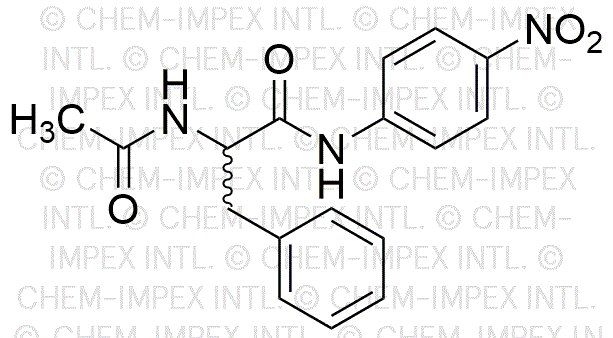Acetyl-DL-phenylalanine 4-nitroanilide is widely utilized in research focused on:
- Biochemical Assays: This compound serves as a substrate in enzyme assays, particularly in studying proteases and peptidases, helping researchers understand enzyme kinetics and mechanisms.
- Drug Development: It is used in pharmaceutical research to evaluate the efficacy of new drug candidates, particularly those targeting neurological disorders, due to its structural similarities to amino acids.
- Analytical Chemistry: This chemical acts as a reagent in various analytical techniques, including chromatography and spectrophotometry, facilitating the detection and quantification of other compounds.
- Protein Synthesis Studies: Researchers utilize it to investigate protein synthesis and folding, contributing to the development of biotechnological applications in protein engineering.
- Educational Purposes: It is often employed in academic laboratories for teaching purposes, allowing students to explore chemical reactions and molecular interactions in a hands-on environment.
General Information
Properties
Safety and Regulations
Applications
Acetyl-DL-phenylalanine 4-nitroanilide is widely utilized in research focused on:
- Biochemical Assays: This compound serves as a substrate in enzyme assays, particularly in studying proteases and peptidases, helping researchers understand enzyme kinetics and mechanisms.
- Drug Development: It is used in pharmaceutical research to evaluate the efficacy of new drug candidates, particularly those targeting neurological disorders, due to its structural similarities to amino acids.
- Analytical Chemistry: This chemical acts as a reagent in various analytical techniques, including chromatography and spectrophotometry, facilitating the detection and quantification of other compounds.
- Protein Synthesis Studies: Researchers utilize it to investigate protein synthesis and folding, contributing to the development of biotechnological applications in protein engineering.
- Educational Purposes: It is often employed in academic laboratories for teaching purposes, allowing students to explore chemical reactions and molecular interactions in a hands-on environment.
Documents
Safety Data Sheets (SDS)
The SDS provides comprehensive safety information on handling, storage, and disposal of the product.
Product Specification (PS)
The PS provides a comprehensive breakdown of the product’s properties, including chemical composition, physical state, purity, and storage requirements. It also details acceptable quality ranges and the product's intended applications.
Certificates of Analysis (COA)
Search for Certificates of Analysis (COA) by entering the products Lot Number. Lot and Batch Numbers can be found on a product’s label following the words ‘Lot’ or ‘Batch’.
*Catalog Number
*Lot Number
Certificates Of Origin (COO)
This COO confirms the country where the product was manufactured, and also details the materials and components used in it and whether it is derived from natural, synthetic, or other specific sources. This certificate may be required for customs, trade, and regulatory compliance.
*Catalog Number
*Lot Number
Safety Data Sheets (SDS)
The SDS provides comprehensive safety information on handling, storage, and disposal of the product.
DownloadProduct Specification (PS)
The PS provides a comprehensive breakdown of the product’s properties, including chemical composition, physical state, purity, and storage requirements. It also details acceptable quality ranges and the product's intended applications.
DownloadCertificates of Analysis (COA)
Search for Certificates of Analysis (COA) by entering the products Lot Number. Lot and Batch Numbers can be found on a product’s label following the words ‘Lot’ or ‘Batch’.
*Catalog Number
*Lot Number
Certificates Of Origin (COO)
This COO confirms the country where the product was manufactured, and also details the materials and components used in it and whether it is derived from natural, synthetic, or other specific sources. This certificate may be required for customs, trade, and regulatory compliance.


